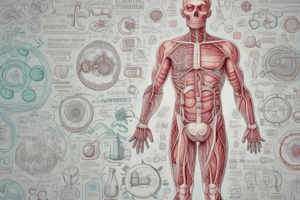Podcast
Questions and Answers
Which enzyme deficiency leads to failure to synthesize urea and hyperammonemia during the first week after birth?
Which enzyme deficiency leads to failure to synthesize urea and hyperammonemia during the first week after birth?
- Carbamoyl phosphate synthetase I
- Arginase
- Ornithine transcarbamylase (correct)
- Argininosuccinate synthetase
What is the toxic substance especially to the central nervous system in the context of urea cycle deficiency?
What is the toxic substance especially to the central nervous system in the context of urea cycle deficiency?
- Urea
- Glutamine
- Ammonia (correct)
- Blood urea nitrogen (BUN)
What combination of symptoms suggests a defect in the urea cycle?
What combination of symptoms suggests a defect in the urea cycle?
- Elevated blood glucose, hypocalcemia, decreased blood urea nitrogen (BUN)
- Hypokalemia, decreased blood urea nitrogen (BUN), normal blood pH
- Hypernatremia, elevated blood creatinine, increased blood urea nitrogen (BUN)
- Hyperammonemia, elevated blood glutamine, decreased blood urea nitrogen (BUN) (correct)
What symptoms typically appear during the 24 to 72-hour postnatal period if there is a defect in the urea cycle?
What symptoms typically appear during the 24 to 72-hour postnatal period if there is a defect in the urea cycle?
What mechanism of ammonia intoxication leads to brain edema?
What mechanism of ammonia intoxication leads to brain edema?
Flashcards are hidden until you start studying
Study Notes
Urea Cycle Deficiency
- Ornithine transcarbamylase (OTC) deficiency leads to failure to synthesize urea and hyperammonemia during the first week after birth.
Toxic Substance
- Ammonia is especially toxic to the central nervous system in the context of urea cycle deficiency.
Symptoms of Urea Cycle Defect
- A combination of symptoms suggesting a defect in the urea cycle includes lethargy, vomiting, hypotonia, and seizures.
Symptoms in Newborns
- Symptoms typically appear during the 24 to 72-hour postnatal period if there is a defect in the urea cycle, including lethargy, vomiting, and seizures.
Ammonia Intoxication
- The mechanism of ammonia intoxication leading to brain edema is due to the production of glutamine in the brain.
Studying That Suits You
Use AI to generate personalized quizzes and flashcards to suit your learning preferences.



